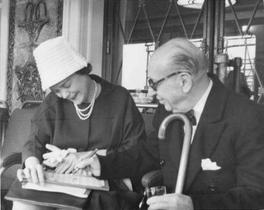Stravinsky

Two cimbalom players!
It was 1960.
Toni had been playing the Hary Janos with various symphony orchestras, major and minor, for several years when she received a call from Igor Stravinsky’s associate Robert Craft asking if she would record Ragtime for Eleven Instruments and Renard with the Composer.
She said yes.
Stravinsky became interested in the cimbalom when he made the acquaintance of cimbalom player Aladár Rácz in Geneva in 1915. He was so taken with it he acquired an instrument for himself and learned to play it.
In the Composer’s words: “I composed the Ragtime at the cimbalom, and the sonority of the whole ensemble is grouped around the sonority of that instrument which I loved so much that I continued to play it every day in my Pleyel Studio in Paris between the wars, though I wrote no more music for it because of the difficulty of finding good players.”
It’s possible to piece together a little scenario from the following: When the Composer was preparing Les Noces and performances were being planned for the still unperformed Renard, Stravinsky sent his beloved cimbalom off to be fitted out as a pianola, intending to make piano rolls so these works could be performed. Apparently working with Aladar Rácz presented problems. (Rácz was something of a phenomenon and his playing had also swayed Kodaly and Bartok to write their scores that included the cimbalom.)
Toni took on the extraordinary challenge of the original parts. There was no model to see how they worked within the ensemble or how it should sound. The writing was uncharacteristic of the accustomed technique and use of the instrument. (Now, of course, it has become business as usual.) The constant changes in meter alone made it devilishly difficult.
In the years that have elapsed since Toni said “yes” to Robert Craft, there are many who have learned to play the cimbalom. Not only are these wonderful pieces now played often, a number of new works have been composed for this beautiful instrument.
Toni had been playing the Hary Janos with various symphony orchestras, major and minor, for several years when she received a call from Igor Stravinsky’s associate Robert Craft asking if she would record Ragtime for Eleven Instruments and Renard with the Composer.
She said yes.
Stravinsky became interested in the cimbalom when he made the acquaintance of cimbalom player Aladár Rácz in Geneva in 1915. He was so taken with it he acquired an instrument for himself and learned to play it.
In the Composer’s words: “I composed the Ragtime at the cimbalom, and the sonority of the whole ensemble is grouped around the sonority of that instrument which I loved so much that I continued to play it every day in my Pleyel Studio in Paris between the wars, though I wrote no more music for it because of the difficulty of finding good players.”
It’s possible to piece together a little scenario from the following: When the Composer was preparing Les Noces and performances were being planned for the still unperformed Renard, Stravinsky sent his beloved cimbalom off to be fitted out as a pianola, intending to make piano rolls so these works could be performed. Apparently working with Aladar Rácz presented problems. (Rácz was something of a phenomenon and his playing had also swayed Kodaly and Bartok to write their scores that included the cimbalom.)
Toni took on the extraordinary challenge of the original parts. There was no model to see how they worked within the ensemble or how it should sound. The writing was uncharacteristic of the accustomed technique and use of the instrument. (Now, of course, it has become business as usual.) The constant changes in meter alone made it devilishly difficult.
In the years that have elapsed since Toni said “yes” to Robert Craft, there are many who have learned to play the cimbalom. Not only are these wonderful pieces now played often, a number of new works have been composed for this beautiful instrument.
